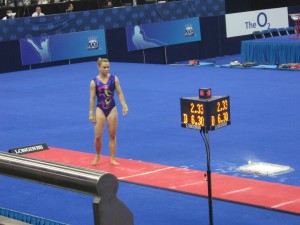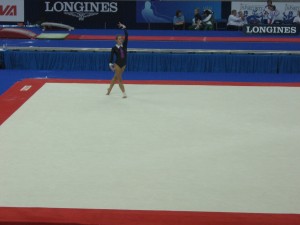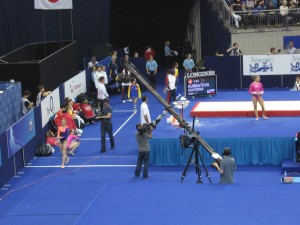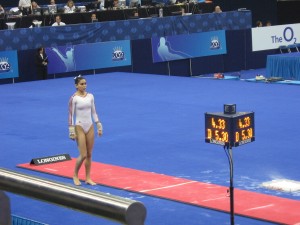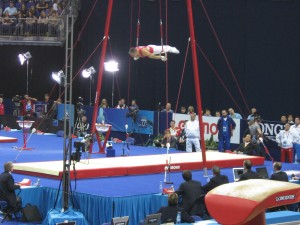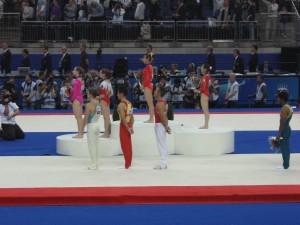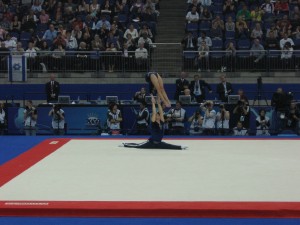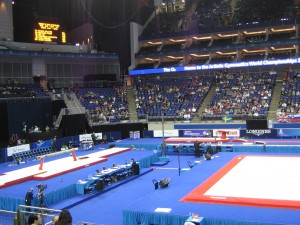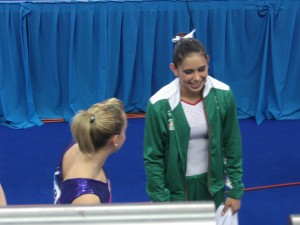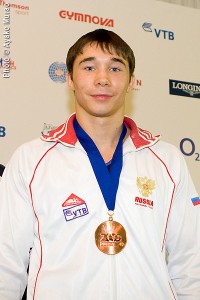2010 Montreal World Cup
“Shusuke Kikuchi!”…”Jad Mazahreh!”…the announcer put on some great accents as he presented the gymnasts at the second annual Montreal World Cup. Although the field was a bit sparse, there was some great gymnastics on display.
The class of the field on floor exercise was Japanese Shusuke Kikuchi, who won by 0.65 over teammate Kyoichi Watanabe and Canadian Kevin Lytwyn. His routine included three double layouts: layout Arabian double front, layout half-in half-out to punch front-1 1/4, and a double layout dismount. Throw in three more twisting passes, and there’s your winner!
Shusuke Kikuchi (JPN), Floor Exercise, 2010 Montreal World Cup
Jordanian Ali Al Asi showed some interesting skills as well, starting with a double-twisting double layout, showing off a really low planche hold, and ending with a double layout (hands down).
Ali Al Asi (JOR), Floor Exercise, 2010 Montreal World Cup
The Finns had two young gymnasts in the floor final, Sakari Vekki (who qualified in second place behind Kikuchi) and Tomi Tuuha. The Austrians also had two gymnasts at the Montreal World Cup: Marco Mayr, who qualified to most of the event finals, and Julian Egermann, who ended up only competing on vault. He was set to perform in the floor final as well, but he suffered a scary fall to his back during the general warm up and appeared to have the wind knocked out of him.
The crowd was treated to one of the international stars on pommel horse. Krisztian Berki of Hungary displayed superb extension and a lengthy routine on his way to the gold medal, 1.15 points over silver medallist Canadian Ken Ikeda.
Krisztian Berki (HUN), Pommel Horse, 2010 Montreal World Cup
Kevin Lytwyn gave the home crowd something to cheer for with his rings routine. He defeated Ali Al Asi, who led the field in qualifications, with steady iron crosses and a stick on his layout full-out dismount.
Kevin Lytwyn (CAN), Rings, 2010 Montreal World Cup (and Maria Karpova’s beam!)
Nathan Gafuik provided the other gold medal for the Canadian team on vault with his Yurchenko-2.5 (stuck!) and his tucked double front (just about stuck!). Kikuchi and Tomi Tuuha (FIN) were both close on Gafuik’s heels, each with a Kasamatsu-2.5 and a layout Rudi.
Nathan Gafuik (CAN), Vault 2, 2010 Montreal World Cup
Tomi Tuuha (FIN), Vault 1, 2010 Montreal World Cup
Kyoichi Watanabe showed a lightness in his clean work on parallel bars to win the title on this event. The two Canadians placed second and third, and they were the only gymnasts to perform double backs between the bars (a Belle for Ikeda and a Morisue for Lytwyn). Tomi Tuuha dismounted with a not-often-seen layout front full.
Kyoichi Watanabe (JPN), Parallel Bars, 2010 Montreal World Cup
Ken Ikeda (CAN), Parallel Bars, 2010 Montreal World Cup
High bar was as exciting as always, with a field that included Slovenian Aljaz Pegan performing his signature release skill. It’s funny to see Pegan in training with his legs everywhere, but then in competition he showed the Montreal crowd the routine and the excellent form that has won him so many medals. This time he lost the title by just 0.1 despite putting his hands down on his triple back dismount.
Topping the field was Kohei Kameyama, bringing home the third gold of this competition to his native Japan. The highlight of his routine for me was not so much his super Kolman or the layout full-out dismount, but his exquisite toepoint! It’s hard to see with his competition socks on, but I have never seen a male gymnast with such a great toepoint before. It was reminiscent of Lilia Podkopayeva and the Fraguas sisters! Canadian Jackson Payne grabbed the bronze medal despite a fall after an Endo-full to layout Jaeger. He ended with a stuck double twisting double layout.
Kohei Kameyama (JPN), High Bar, 2010 Montreal World Cup
Aljaz Pegan (SLO), High Bar, 2010 Montreal World Cup
Jackson Payne (CAN), High Bar, 2010 Montreal World Cup
And there you have it…. This is only the second time this city has hosted the Montreal World Cup event, and I’m looking forward to attending in years to come. Last year the women’s side had a very small field and it was cancelled altogether this time around, but hopefully in the years to come this meet will develop into a competition as great as the DTB Cup and the Glasgow Grand Prix.
Posted in News | 1 Comment »

